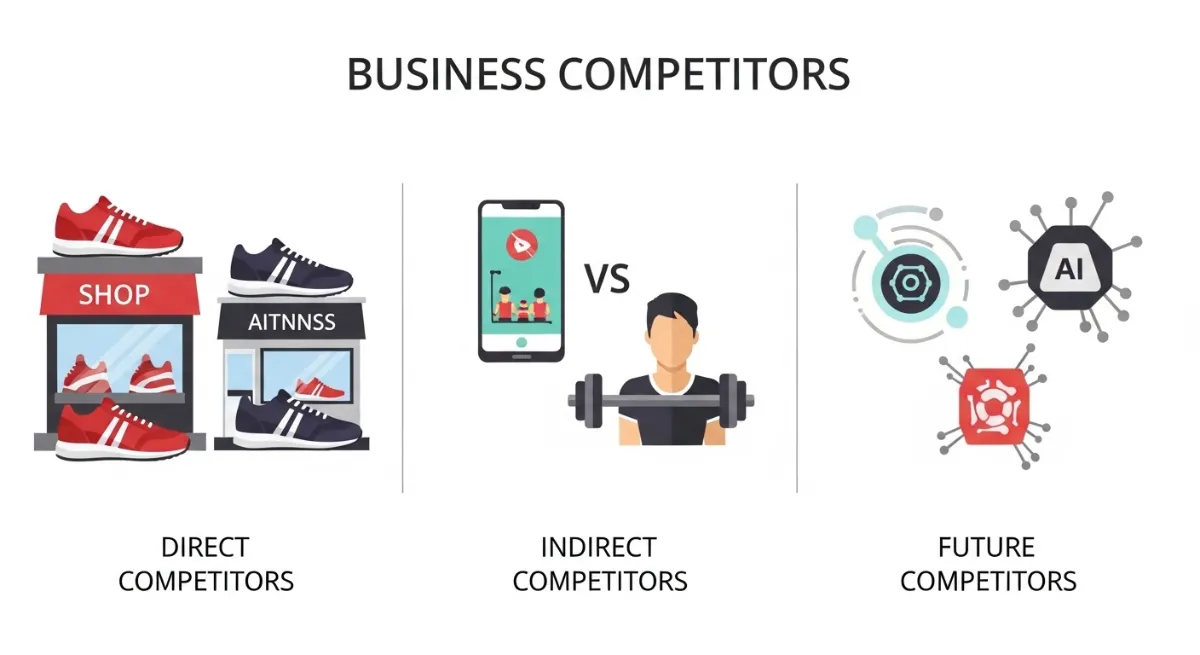What is Competitor Market Analysis?
Competitor market analysis is the practice of studying your competitors to understand their strategies, strengths, weaknesses, and market position. It goes beyond simply knowing “who they are”—it’s about breaking down how they operate, why customers choose them, and how your business can use these insights to grow.
For instance, if you run a digital marketing agency, analyzing a competitor’s SEO approach shows you which keywords are driving their organic traffic, how they structure their content, and whether they rely more on blogs, videos, or case studies. Similarly, looking at their paid ads can reveal how aggressively they spend on Google or Facebook campaigns. By evaluating these details, you can make smarter decisions about where to focus your energy and budget.
Competitor market analysis is not about copying strategies—it’s about finding gaps where your brand can stand out. Many businesses assume they know what competitors are doing, but without structured research, they often miss critical details like customer pain points, social media engagement patterns, or product positioning.
Why Competitor Market Analysis Matters
In today’s competitive environment, businesses that fail to keep an eye on competitors risk losing their market share quickly. Customers are constantly comparing alternatives before making a purchase. If you don’t know what’s being offered by others, you might be underselling your strengths or pricing yourself out of the market.

Some of the major benefits of competitor analysis include:
- Discovering Market Trends – Competitors often adopt new technologies, marketing tactics, or platforms early. By analyzing them, you can identify emerging trends before they become mainstream.
- Improving Customer Understanding – Customer reviews and competitor campaigns reveal what audiences value most. This helps refine your own messaging and offers.
- Avoiding Mistakes – Observing failures in competitor campaigns or product launches can save you time and money.
- Shaping Unique Value Propositions (UVPs) – By learning how others describe their offerings, you can highlight what truly sets your business apart.
- Boosting Profitability – Instead of running endless experiments, you leverage proven tactics and adjust them for better results.
Think of competitor analysis as your business compass—it points you toward growth opportunities and warns you about potential pitfalls.
Core Elements of Competitor Market Analysis
A successful competitor market analysis usually covers the following dimensions:
- Market Positioning
Competitors often position themselves as premium, affordable, or niche specialists. By identifying their positioning, you can decide whether to match them, differentiate, or serve an entirely overlooked segment. - Target Audience
Who are they marketing to? If their primary audience is small businesses, could you focus on enterprise clients? Or vice versa? Audience overlap and gaps give valuable direction. - Marketing Strategies
From SEO to influencer marketing, each competitor chooses different channels. Studying these choices shows which strategies are paying off. For example, a competitor with strong LinkedIn engagement may suggest B2B customers are active there. - Product and Service Offering
Features, pricing models, and service add-ons are crucial. A competitor may attract customers by offering free consultations, extended warranties, or subscription bundles. Identifying these can inspire your next service innovation. - Reputation & Customer Feedback
Reviews, testimonials, and case studies reveal what customers praise and where they complain. Positive feedback highlights strengths to match, while negative reviews show areas where you can excel.
Different Types of Competitors to Analyze
Not every competitor should be treated equally. Breaking them into categories improves clarity:

- Direct Competitors – They sell the same product or service to the same target audience. Example: Two e-commerce stores selling athletic shoes.
- Indirect Competitors – They target the same customers but with different solutions. Example: A fitness app vs. a personal trainer.
- Future or Emerging Competitors – Startups and innovative businesses may not threaten you today, but they can disrupt the market tomorrow. Example: AI-driven platforms in digital marketing.
By looking at all three, you prepare not only for today’s challenges but also for future disruptions.
Step-by-Step Process to Conduct Competitor Market Analysis
- Identify Key Competitors
- Use Google searches, industry reports, and customer surveys to create a list. Aim for 5–10 solid names.
- Collect Relevant Data
- Explore websites, follow social channels, and use tools like SEMrush or Ahrefs to gather SEO insights.
- Study Strengths and Weaknesses
- Compare what competitors do better (e.g., faster delivery) and where they fall short (e.g., poor customer support).
- Benchmark Metrics
- Set benchmarks for engagement, pricing, and conversion rates. This gives you measurable performance goals.
- Develop Actionable Insights
- Use findings to refine your products, pricing, and marketing. For example, if competitors succeed with video ads, test video content in your campaigns.
Key Areas of Competitor Market Analysis
| Element | Why It Matters | Example Questions to Ask |
|---|---|---|
| Market Positioning | Shows brand perception & pricing tiers | Are they premium, mid-range, or budget? |
| Target Audience | Reveals customer demographics | Who are they trying to reach? |
| Marketing Strategies | Highlights promotional effectiveness | Which channels bring the most traffic? |
| Product/Service Offering | Identifies gaps in your own business | What features do they have that you don’t? |
| Customer Reputation | Shows satisfaction & pain points | What do reviews and ratings reveal? |
Pro Tip 💡
When starting competitor analysis, don’t rely only on the most popular brands. Smaller competitors often reveal innovative approaches—they pivot faster, try new marketing channels, and target micro-niches that large players ignore. Monitoring them can uncover opportunities before your bigger rivals notice.
Why Tools Are Essential in Competitor Analysis
Competitor market analysis requires collecting and interpreting large amounts of data—search engine rankings, social media engagement, paid ads, customer reviews, and more. Doing all of this manually is nearly impossible. This is where tools come in.
Competitor analysis tools automate the process, allowing you to:
- Track competitor websites and traffic sources.
- Monitor keyword rankings.
- Compare advertising campaigns.
- Study social media performance.
- Identify backlinks and partnerships.
Using the right tools not only saves time but also ensures accuracy, giving you reliable insights for decision-making.
Best Competitor Analysis Tools for Businesses
Businesses today rely on advanced software to understand what competitors are doing online. Below is a comparison of some of the best competitor analysis tools used worldwide.
Best Competitor Analysis Tools Comparison
| Tool | Best For | Key Features | Pricing (approx.) |
|---|---|---|---|
| SEMrush | SEO & digital marketing | Keyword research, site audits, backlink data, competitor traffic insights | From $129/mo |
| Ahrefs | Backlinks & keyword research | Site Explorer, competitor backlink analysis, keyword difficulty | From $99/mo |
| SpyFu | PPC & advertising analysis | Competitor ad spend tracking, Google Ads insights | From $39/mo |
| SimilarWeb | Website traffic sources | Competitor traffic analytics, audience interests, engagement metrics | From $125/mo |
| BuzzSumo | Content marketing analysis | Top-performing content, influencer discovery, competitor content strategy | From $99/mo |
Each of these tools specializes in different aspects of analysis. For example, SEMrush and Ahrefs are industry favorites for SEO, while BuzzSumo is excellent for content marketing. If your focus is advertising, SpyFu provides detailed PPC competitor insights.
Social Media Competitor Analysis Tools
In today’s digital landscape, social media can make or break a brand. Platforms like Facebook, Instagram, LinkedIn, and TikTok are not just marketing channels—they are also key sources of competitor intelligence. Monitoring how competitors perform on social media helps businesses identify content trends, engagement tactics, and audience preferences.
Some of the best social media competitor analysis tools include:
- Hootsuite – Allows you to track competitor posting frequency, engagement rates, and trending hashtags.
- Sprout Social – Provides detailed competitor reports on content performance and customer engagement.
- Social Blade – Tracks growth statistics on YouTube, Instagram, and Twitch, showing follower trends and performance benchmarks.
- Brandwatch – Specializes in social listening, allowing you to monitor competitor mentions, sentiment, and campaign effectiveness.
- Phlanx – Useful for analyzing Instagram engagement rates and influencer activity.
By using these tools, businesses can identify which types of posts perform best, which platforms generate the most engagement, and how often competitors interact with their audiences.
Key Strategies for Competitor Market Analysis
While tools provide the data, strategies turn those numbers into actionable insights. Below are some proven approaches for effective analysis:
1. Keyword & SEO Benchmarking
Use tools like SEMrush and Ahrefs to identify competitor keywords, content strategies, and backlink sources. This helps you:
- Spot high-ranking keywords you’re missing.
- Discover backlink opportunities from the same sources.
- Understand how competitors structure their content for SEO.

2. Paid Advertising Analysis
Platforms like SpyFu allow you to see which ads competitors run, how much they spend, and which keywords they target. This information reveals:
- Seasonal promotions.
- Budget allocation between different campaigns.
- Ad copy strategies that resonate with audiences.
3. Social Media Content Study
By analyzing competitor engagement rates, you can see:
- Which content formats work best (videos, reels, carousels, live streams).
- Posting frequency and best times for audience activity.
- Types of captions, hashtags, and CTAs that generate results.
4. Customer Experience Analysis
Beyond online campaigns, studying competitor customer reviews and testimonials highlights:
- What customers love about their services.
- Common complaints you can turn into opportunities.
- Trends in customer expectations.
5. Benchmarking Conversion Funnels
Examine how competitors guide visitors through their websites—from landing pages to checkout. This shows you whether their calls-to-action (CTAs), page layouts, or offers outperform yours.
Real-World Example
Imagine you run an e-commerce store selling eco-friendly skincare. By analyzing a competitor’s social media campaigns, you notice that their Instagram reels about “morning skincare routines” generate thousands of likes. Their paid ads, however, don’t get much engagement. Using these insights, you might:
- Repurpose short video tutorials for your audience.
- Focus less on paid ads and more on organic influencer partnerships.
- Offer an additional bonus like free eco-friendly packaging—something customers are requesting in their reviews.
This approach doesn’t just imitate; it strategically adapts based on what’s working and what’s failing for others.
Pro Tip 💡
Don’t limit competitor analysis to only one channel (like SEO or social media). Multi-channel analysis is far more effective. A competitor might dominate search engines but struggle on social platforms—or vice versa. By analyzing across SEO, PPC, and social media, you’ll uncover a complete picture and identify hidden growth opportunities.
Turning Insights into Growth From Data to Strategy
Competitor market analysis is only valuable if it leads to action. Gathering data is the easy part; the real challenge lies in converting insights into strategies that drive measurable business growth. Far too many businesses collect competitor reports but fail to integrate findings into their marketing, sales, and product development plans.

The key is to approach competitor analysis with a strategic mindset: what can this data teach me about my customers, my market, and my own weaknesses? Once you answer this, you can begin shaping initiatives that strengthen your position in the market.
How to Apply Competitor Insights
Here are practical ways businesses can use competitor insights to grow:
1. Enhancing Marketing Campaigns
By analyzing which campaigns competitors are investing in, you gain a roadmap of where to allocate resources. For example:
- If competitors get strong engagement on LinkedIn posts, it may suggest that B2B clients in your industry are most active there.
- If competitor YouTube tutorials consistently outperform blogs, your audience may prefer video over text.
Using these insights, you can adapt your strategy while adding unique value through your brand voice and expertise.
2. Refining Pricing & Offers
Competitor pricing models reveal customer expectations. If most rivals offer bundle deals or free shipping, not doing so might push potential buyers away. Similarly, analyzing competitor promotions (holiday sales, discount codes, limited-time offers) helps you design more compelling offers.
3. Improving Customer Experience
Customer reviews and social media conversations often highlight competitor pain points—such as poor response times, complicated websites, or hidden charges. Addressing these gaps in your own business builds trust and positions your brand as a better alternative.
4. Boosting Content & SEO Strategy
If competitors rank for high-volume keywords, you can create more detailed or fresher content to compete. For example, if a competitor ranks for “best digital marketing tools 2025,” writing an in-depth guide with updated data could outrank them. Competitor backlink profiles also show where they’re earning authority, giving you ideas for your own outreach campaigns.
5. Product & Service Innovation
Sometimes, competitor analysis reveals features customers expect but you don’t yet provide. By incorporating these into your offering—or innovating further—you can increase customer satisfaction. For instance, if competitors in your niche offer 24/7 customer support, adding this feature could immediately boost your reputation.
Case-Style Example
Imagine a mid-sized SaaS company offering project management software. After conducting a competitor market analysis, they discover:
- Competitors’ blogs about remote work attract thousands of monthly visitors.
- A rival company’s free version of the tool is widely popular, but customers complain about lack of customer support.
- Competitors spend heavily on paid ads but neglect influencer partnerships on LinkedIn.
By using these insights, the company could:
- Launch a comprehensive content series about remote collaboration to capture organic traffic.
- Create a “freemium” version of their software but pair it with strong support to stand out.
- Partner with LinkedIn influencers in the productivity space instead of overspending on ads.
Within six months, this strategy could help them increase signups, improve customer satisfaction, and differentiate from competitors.
Future Trends in Competitor Market Analysis
The way businesses analyze competitors is evolving. Staying ahead means embracing new trends:
- AI-Driven Analysis
Artificial intelligence is making competitor analysis faster and smarter by predicting market shifts, identifying new competitors, and even analyzing sentiment in customer reviews at scale. - Predictive Analytics
Instead of just looking at current trends, predictive analytics allows businesses to forecast where markets are heading. This helps companies adjust strategies proactively.

- Comprehensive Social Listening
With conversations happening across countless platforms, businesses are using advanced tools to monitor not just brand mentions, but also competitor sentiment, hashtags, and viral trends. - Integrated Dashboards
Future tools will provide unified dashboards combining SEO, PPC, content, and social metrics. This means less manual reporting and more time for strategy. - Ethical & Privacy Considerations
As data privacy laws tighten, competitor analysis will need to adapt. Ethical data collection will become a priority for businesses that want to avoid legal risks.
Common Mistakes to Avoid
Even with the best tools, many businesses stumble in their competitor analysis efforts. Avoid these pitfalls:
- Copying instead of innovating: Competitor insights should inspire, not dictate.
- Ignoring indirect competitors: Sometimes, threats come from unexpected industries.
- Analyzing too rarely: One-time analysis isn’t enough—markets evolve constantly.
- Drowning in data: Collecting too much information without action wastes time.
Pro Tip 💡
Competitor analysis should never be a one-time project. Benchmark your competitors regularly—quarterly or even monthly—to stay updated with market shifts. Competitors will evolve, and if you’re not monitoring them consistently, you risk falling behind.
conclusion
In today’s competitive digital landscape, competitor market analysis isn’t optional—it’s essential. Whether you’re a startup trying to establish your presence, a small business looking to outperform local rivals, or an established company aiming to scale with data-driven strategies, a well-executed competitor market analysis can transform how you make decisions and grow.
But analysis alone isn’t enough. Real success comes from knowing how to apply insights strategically, align them with your business goals, and continuously refine your approach. Leveraging the best competitor analysis tools and social media competitor analysis tools ensures that you gather accurate data and actionable insights. That’s where expert guidance makes all the difference.
At FastDigital360, we specialize in helping businesses harness the full potential of competitor insights. From conducting comprehensive competitor market analysis to implementing strategies using the best competitor analysis tools and social media competitor analysis tools, we provide actionable guidance to help your business outperform rivals. Explore our Services to see how we can help your brand grow.
If you’re ready to turn competitor insights into measurable growth, reach out via our Contact page and let’s start building a strategy that works for your unique business needs. Learn more about our journey and expertise on our About Page or return to our Home Page to explore all we offer.
With the right competitor market analysis, combined with best competitor analysis tools and social media competitor analysis tools, your business can outsmart the competition, maximize opportunities, and achieve sustainable growth.
Frequently Asked Questions (FAQ)
1. What is competitor market analysis?
Competitor market analysis is the process of researching and evaluating your competitors’ strategies, strengths, and weaknesses. It helps businesses understand market trends, identify opportunities, and make data-driven decisions to stay ahead of rivals.
2. Why is competitor market analysis important?
It’s important because it allows you to see what your competitors are doing well, where they are falling short, and how you can differentiate your business. Using insights from competitor market analysis, you can improve your marketing, pricing, products, and customer experience.
3. What are the best competitor analysis tools?
Some of the best competitor analysis tools include SEMrush, Ahrefs, SpyFu, SimilarWeb, and BuzzSumo. These tools help track competitor traffic, keyword rankings, backlinks, ad campaigns, and content performance to give you a comprehensive view of the market.
4. How do social media competitor analysis tools help?
Social media competitor analysis tools like Hootsuite, Sprout Social, Brandwatch, and Social Blade allow you to monitor competitors’ engagement, posting frequency, content types, and audience reactions. This helps you create more effective social media strategies and outperform rivals.




